Have you ever wondered what it feels like to hike at 2 AM in broad daylight? Or to watch the sun paint golden circles across the sky while everyone back home is fast asleep? Welcome to Norway’s midnight sun season – nature’s most spectacula light show that turns the Arctic into a photographer’s paradise.
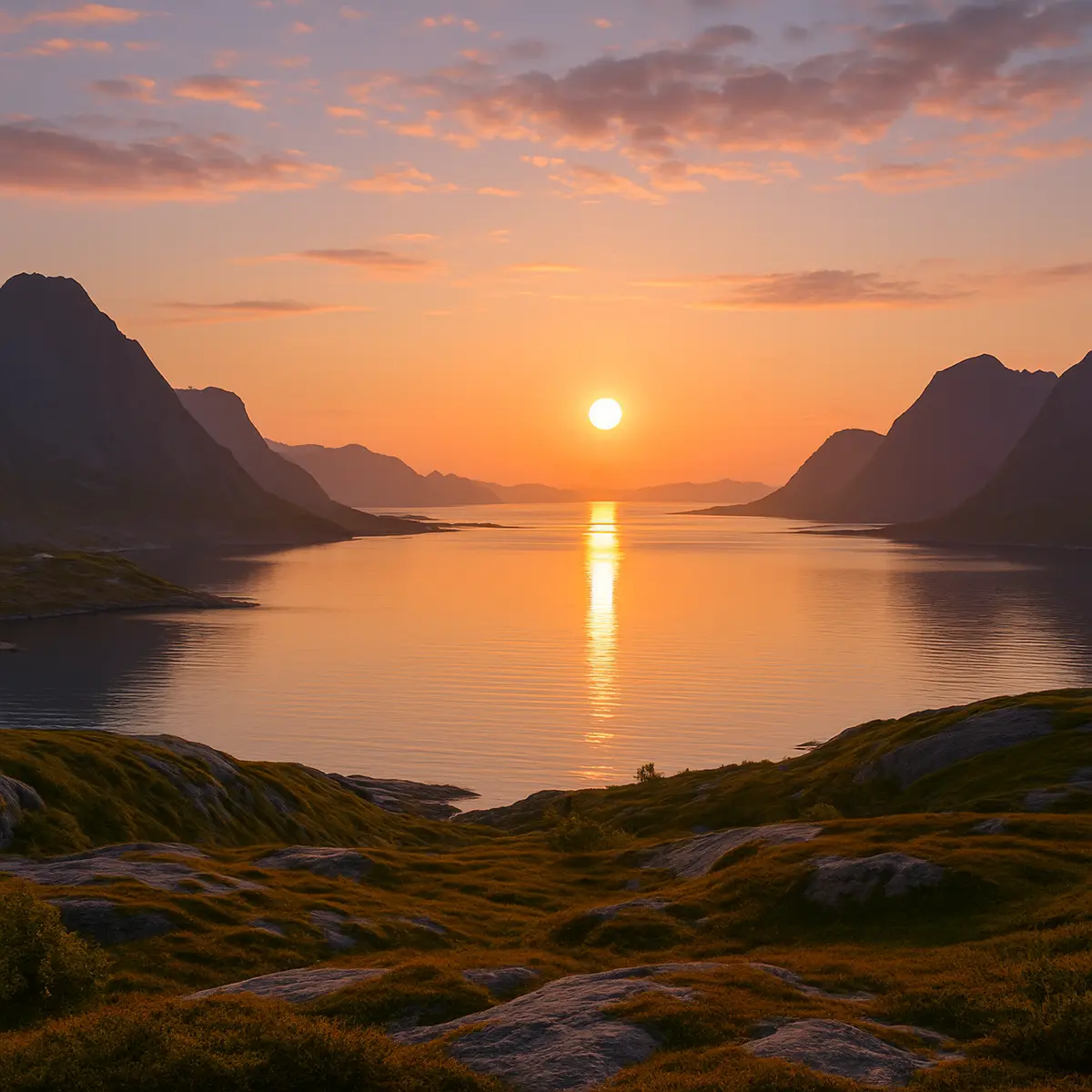
I still remember my first midnight sun experience on the Lofoten Islands. There I was, standing on Reinebringen at what should have been bedtime, watching fishing boats glide across mirror-still waters while the sun hung lazily above the horizon like it had forgotten how to set. It’s the kind of moment that rewires your brain and makes you question everything you thought you knew about time.
What Exactly Is the Midnight Sun?
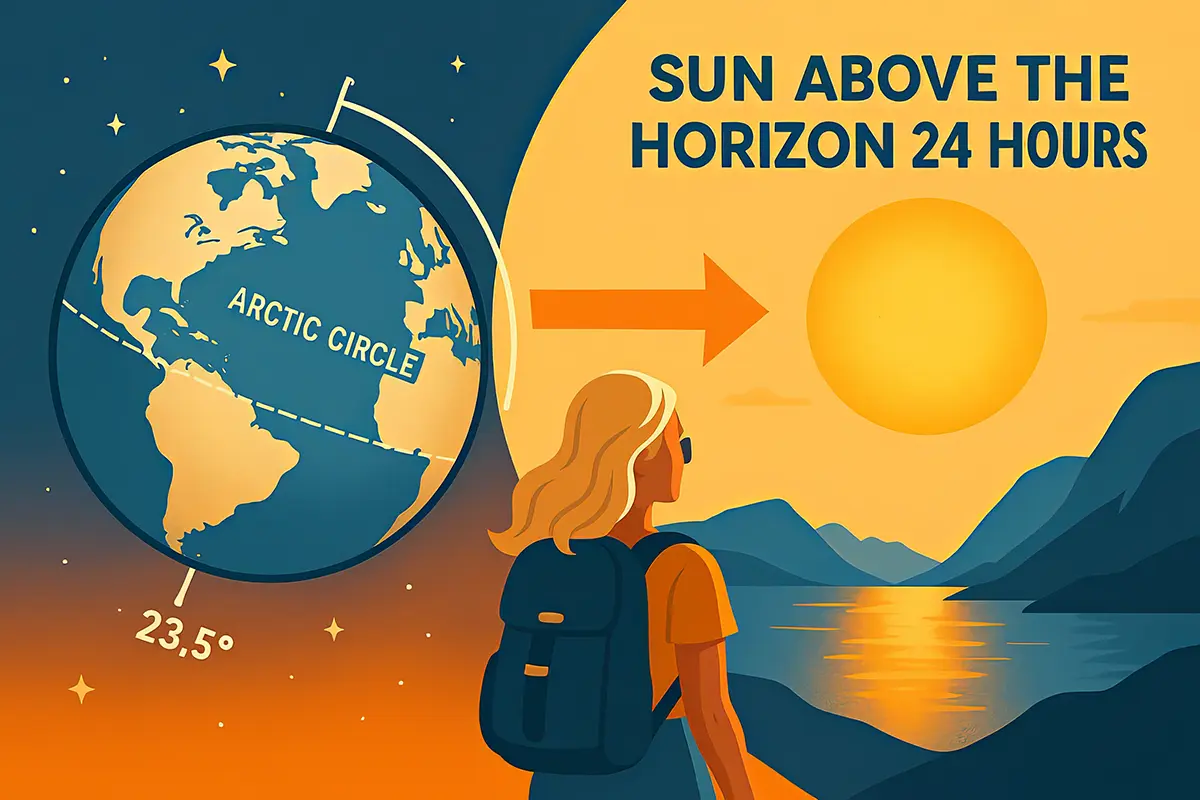
The midnight sun isn’t just “really long daylight” – it’s a complete suspension of the day-night cycle that happens above the Arctic Circle. Between late May and mid-July, the sun literally never sets, creating 24-hour daylight that transforms how you experience the landscape.
But here’s what most guides won’t tell you: the light changes constantly throughout these “endless” days. At traditional sunset hours (around 10-11 PM), you get this incredible golden hour that lasts for hours. Then comes the magic hour around midnight when everything glows amber and pink, followed by a surreal dawn-like quality around 3 AM that makes even the most ordinary scenes look cinematic.
The Science Behind the Phenomenon (Keep It Simple)
Without diving into complicated astronomy, here’s what’s happening: Earth tilts 23.5 degrees on its axis. During summer, the North Pole leans toward the sun so dramatically that Arctic regions never rotate away from sunlight. The further north you go, the longer this effect lasts.
Key dates for 2025:
- Tromsø: May 20 – July 22 (64 days of midnight sun)
- North Cape: May 14 – July 29 (76 days of midnight sun)
- Svalbard: April 20 – August 22 (124 days of midnight sun)
Where to Experience Norway’s Midnight Sun (The Insider Spots)
1. Lofoten Islands: The Crown Jewel
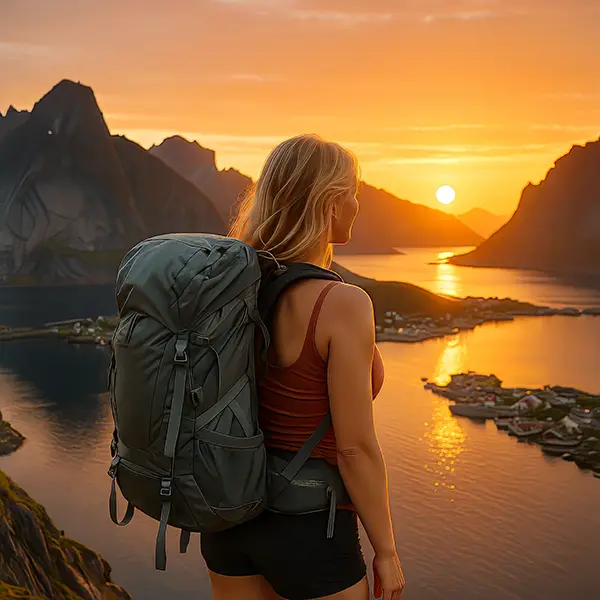
Why it’s special: The Lofoten Islands offer the perfect combination of dramatic peaks, pristine beaches, and fishing villages that look like they’ve been plucked from a fairy tale.
Best photo spots:
- Reinebringen Summit (1.5-hour hike): 360-degree views of the entire Lofoten chain. Arrive by 10 PM for golden hour shots that last until 2 AM.
- Haukland Beach: White sand meets turquoise water with jagged peaks as backdrop. The contrast during midnight sun hours is unreal.
- Nusfjord: Historic fishing village where red rorbuer (fishermen’s cabins) glow like lanterns against the midnight light.
Pro tip: Stay in Reine and hike different peaks each “night.” The light hits each mountain differently throughout the midnight hours.
2. Tromsø: The Northern Lights Capital’s Summer Secret
Most people know Tromsø for aurora hunting, but its midnight sun game is equally impressive.
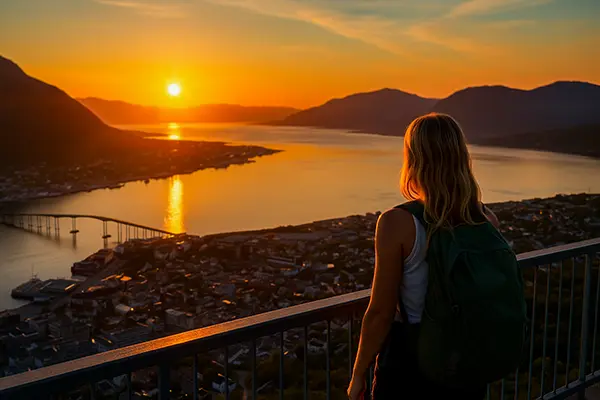
Must-visit spots:
- Fjellheisen Cable Car: Skip the crowded daytime rides. Take the cable car at 11 PM when golden light transforms the entire city and surrounding fjords.
- Kvaløya Island: Drive the scenic route around midnight. The empty roads and ethereal light create an almost post-apocalyptic beauty.
- Ersfjorden Beach: Black sand, white peaks, midnight sun reflecting off the water. It’s like being on an alien planet.
Unique angle: Time your visit around the Midnight Sun Marathon (June 21, 2025). The energy of runners at 2 AM combined with endless daylight creates an unforgettable atmosphere.
3. North Cape: The Edge of the World
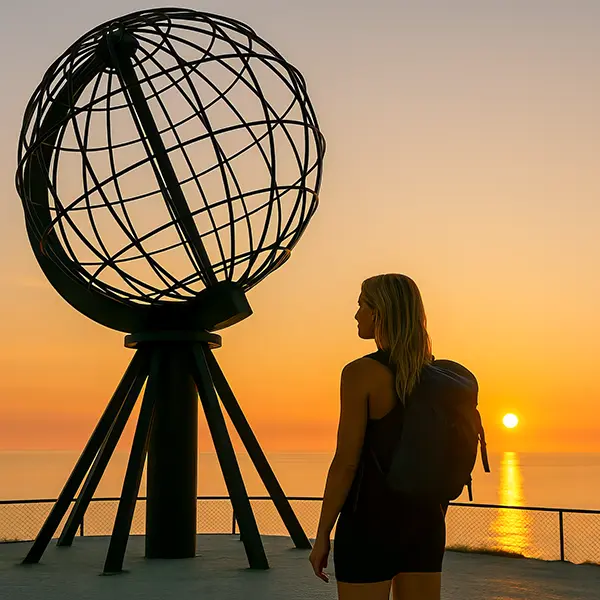
The ultimate midnight sun experience:Standing at Continental Europe’s northernmost point while the sun hovers above the Arctic Ocean.
Photography gold mines:
- North Cape Plateau: Arrive before midnight and watch the sun trace its lowest arc across the horizon.
- Knivskjellodden: The actual northernmost point (requires a 9km hike). You’ll likely have this spot to yourself during midnight hours.
- Honningsvåg: Traditional Sami village where colorful houses pop against the eternal twilight.
4. Svalbard: For the True Adventurers
If you want to go extreme, Svalbard offers the longest midnight sun period – over 4 months.
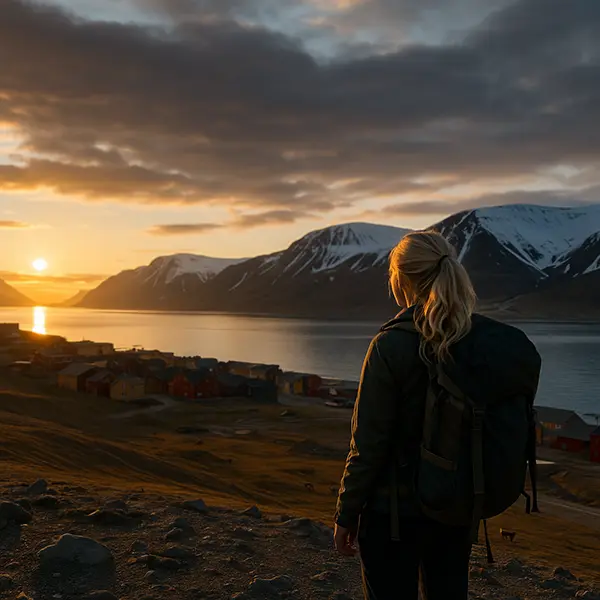
What makes it different: Everything here operates on “polar time.” People hike at 3 AM, have barbecues at midnight, and completely abandon normal schedules.
Essential spots:
- Longyearbyen: The world’s northernmost settlement, where midnight sun creates an otherworldly urban landscape.
- Pyramiden: Abandoned Soviet mining town that’s eerily beautiful under endless light.
Safety note: Polar bear country – guided tours only.
The Photographer’s Guide to Midnight Sun Magic
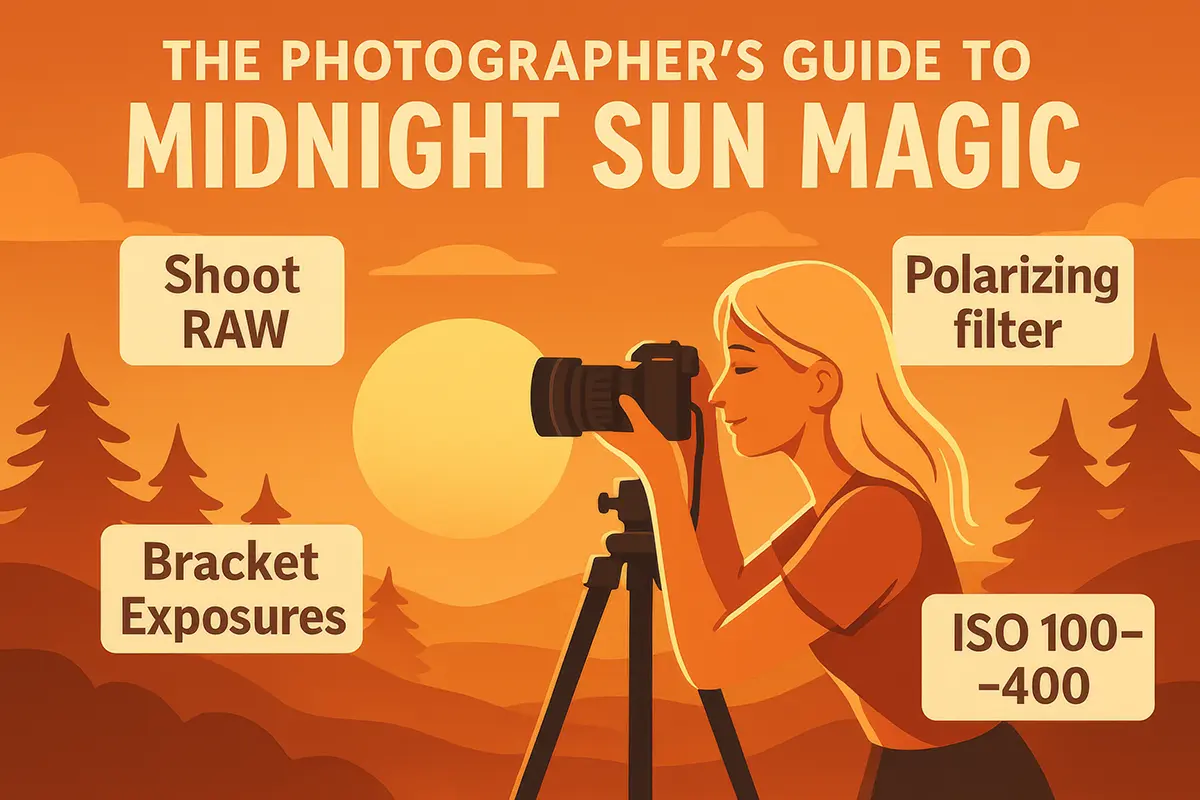
Timing Is Everything
10 PM – Midnight: Golden hour on steroids. Warm, directional light perfect for landscapes and portraits.
Midnight – 2 AM: The “true” midnight sun. Cooler tones, dramatic shadows, surreal atmosphere.
2 AM – 4 AM: Dawn-like quality without actual sunrise. Soft, diffused light ideal for detail shots.
4 AM – 6 AM: Cool morning light returns before the cycle repeats.
Camera Settings That Work
- Shoot RAW: The extreme lighting conditions require heavy post-processing flexibility.
- Use a polarizing filter: Cuts glare from water and snow, enhances sky contrast.
- Bracket exposures: The light changes constantly – HDR saves the day.
- ISO 100-400: You have unlimited light, so keep ISO low for maximum detail.
Compositions That Stand Out
Skip the obvious sunset shots. Everyone photographs the sun hovering above the horizon. Instead:
- Focus on how the light transforms ordinary objects (weathered boats, wildflowers, faces of locals)
- Capture human activity at “impossible” hours (kids playing at 1 AM, fishermen working at 3 AM)
- Use the light as a supporting character, not the main subject
What Nobody Tells You About Living in Endless Light
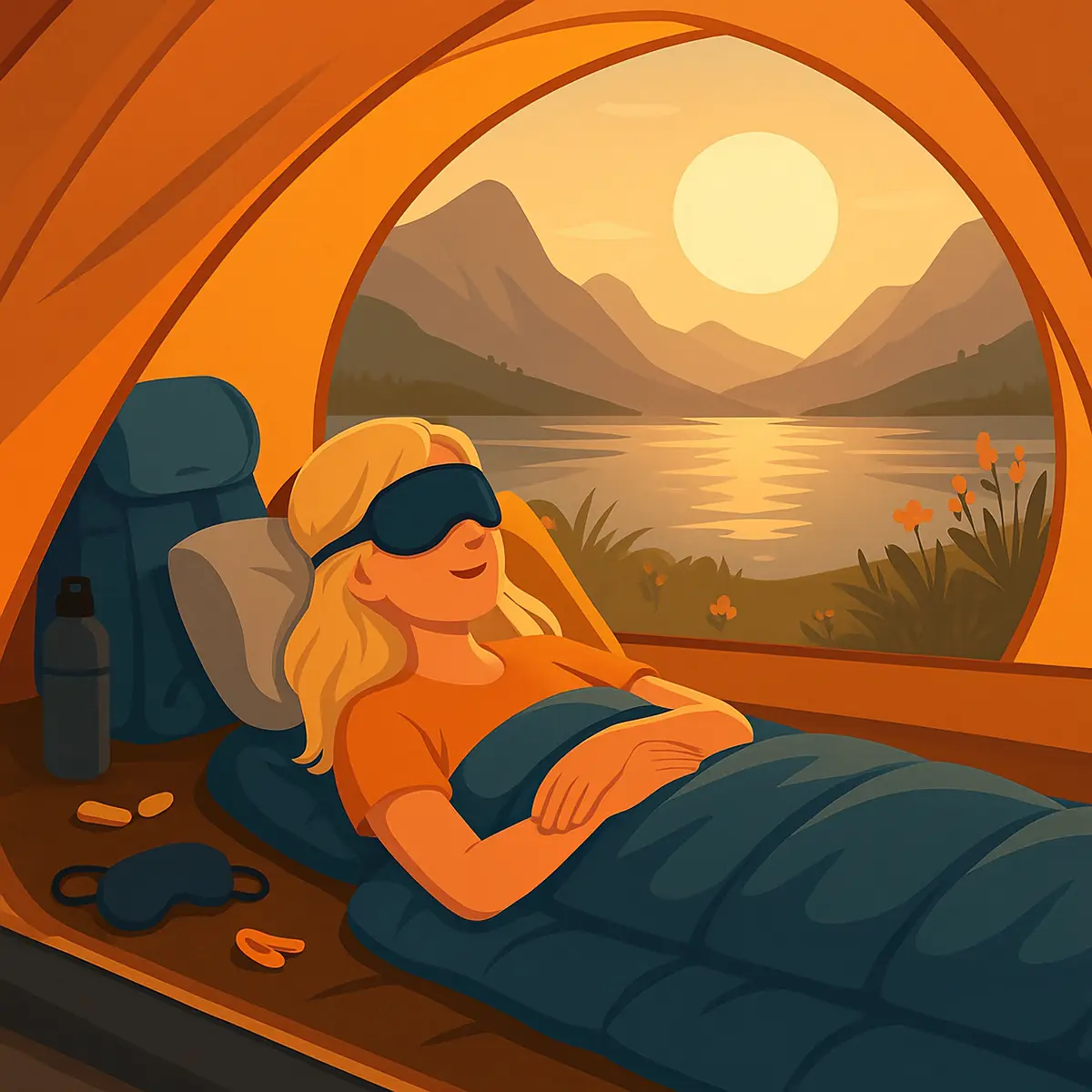
The Sleep Challenge
Your body doesn’t understand what’s happening. Melatonin production gets confused, and you might find yourself wide awake at 3 AM feeling like it’s afternoon.
Survival tactics:
- Pack a sleep mask (seriously, the best investment you’ll make)
- Stick to a schedule – eat meals and sleep at normal times regardless of light
- Embrace the weirdness – some of my best adventures happened during “night” hours when I couldn’t sleep anyway
The Energy Paradox
You’d think endless light would give you endless energy. Instead, many people experience “midnight sun fatigue” – a strange exhaustion that comes from your circadian rhythm being completely disrupted.
How to manage it:
- Take actual breaks indoors
- Don’t try to stay active for 20 hours straight (you’ll burn out by day 3)
- Plan rest days between major activities
The Local Perspective
Norwegians have a word for this: midnattsol. But what’s fascinating is how differently locals handle it compared to tourists.
While visitors frantically try to photograph every moment, locals treat it like an extended evening. They have midnight barbecues, play football at 2 AM, and generally just enjoy the extended social time. There’s something beautiful about adopting this mindset instead of treating it like a once-in-a-lifetime spectacle.
Planning Your Midnight Sun Adventure
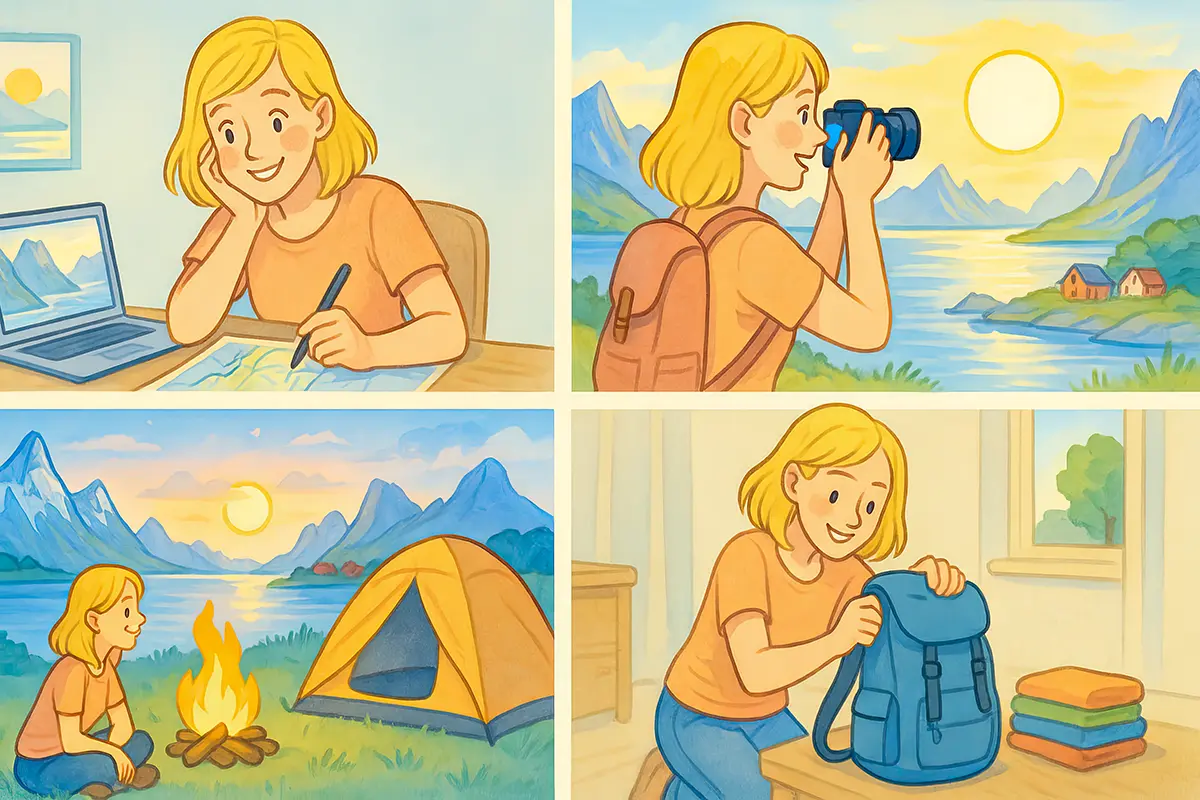
Best Time to Visit
Peak season: Late June to early July offers the most reliable weather and longest days.
Sweet spot: Mid-June provides excellent midnight sun with fewer crowds and better accommodation prices.
Budget option: Late May or late July – slightly shorter midnight sun periods but significantly cheaper.
Accommodation Strategies
Book early: Midnight sun season is peak season. Popular spots like Reine fill up 6 months in advance.
Consider location carefully:
- Stay in Reine for Lofoten access
- Tromsø for urban amenities plus nature
- Honningsvåg for North Cape proximity
Alternative options:
- Camping is popular and practical (you don’t need to worry about darkness)
- Mountain huts offer authentic experiences
- Airbnb in fishing villages provides local insight
Transportation Tips
Rental car: Ultimate flexibility for chasing light and accessing remote spots. Book early – rental cars are scarce during peak season.
Hurtigruten coastal voyage: Unique perspective seeing midnight sun from the water. The ship’s midnight sun deck parties are legendary.
Local flights: SAS and Norwegian offer frequent flights between major northern cities.
Gear Essentials for Midnight Sun Adventures

Photography Equipment
- Tripod: Even with endless light, you’ll want long exposures for water movement
- Polarizing filter: Essential for water reflections and sky contrast
- Extra batteries: Cold weather drains batteries faster
- Lens cloth: Sea spray and condensation are constant issues
Outdoor Gear
- Quality sunglasses: You’ll need them at 2 AM
- Sunscreen: Arctic sun is deceptively strong
- Layers: Temperature can vary dramatically throughout “the day”
- Waterproof jacket: Weather changes quickly in northern Norway
Sleep Kit
- Blackout sleep mask: Non-negotiable
- Earplugs: Activities continue around the clock
- Melatonin supplements: Consult your doctor first
Hidden Gems Most Tourists Miss
Senja Island: The Norway in Miniature
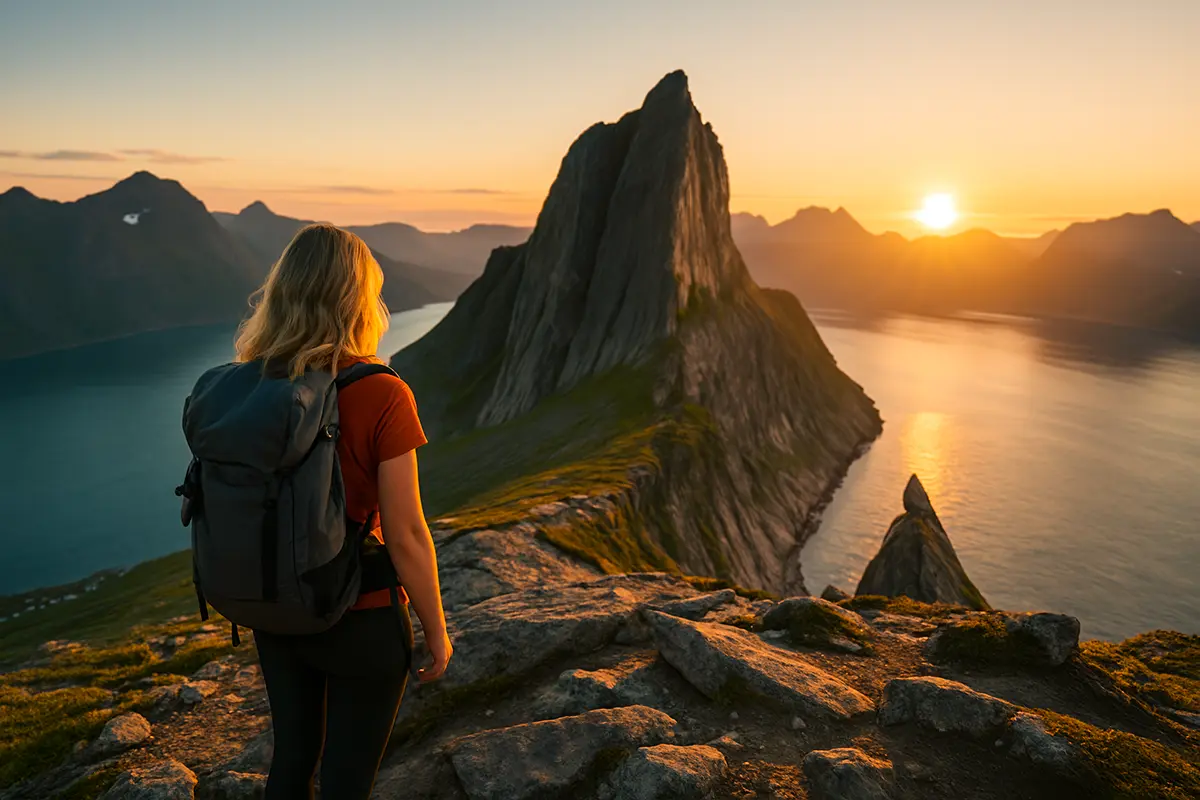
Often called “Norway in miniature,” Senja combines everything that makes Lofoten famous with a fraction of the crowds.
Secret spots:
- Segla Mountain: Lofoten-style peaks without the tour buses
- Bergsbotn Beach: Arctic beach completely to yourself during midnight hours
- Tungeneset: Dramatic coastline perfect for midnight sun photography
Vesterålen Islands: Lofoten’s Quieter Neighbor
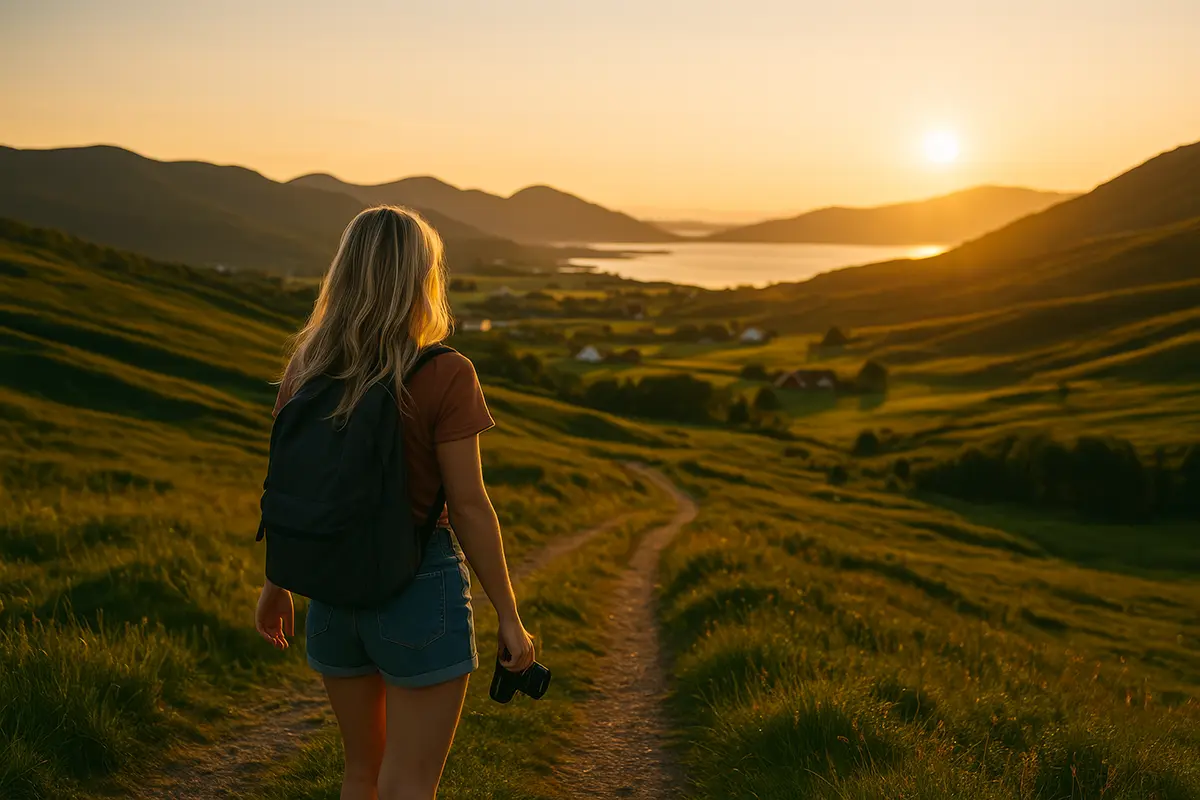
Connected to Lofoten but with a completely different character.
Why it’s special: More rolling hills than jagged peaks, but the midnight sun creates an almost Scottish Highland atmosphere.
Don’t miss: Nyksund – former ghost town turned artist colony where midnight sun illuminates incredible street art.
Finnmark Plateau: The Real Arctic
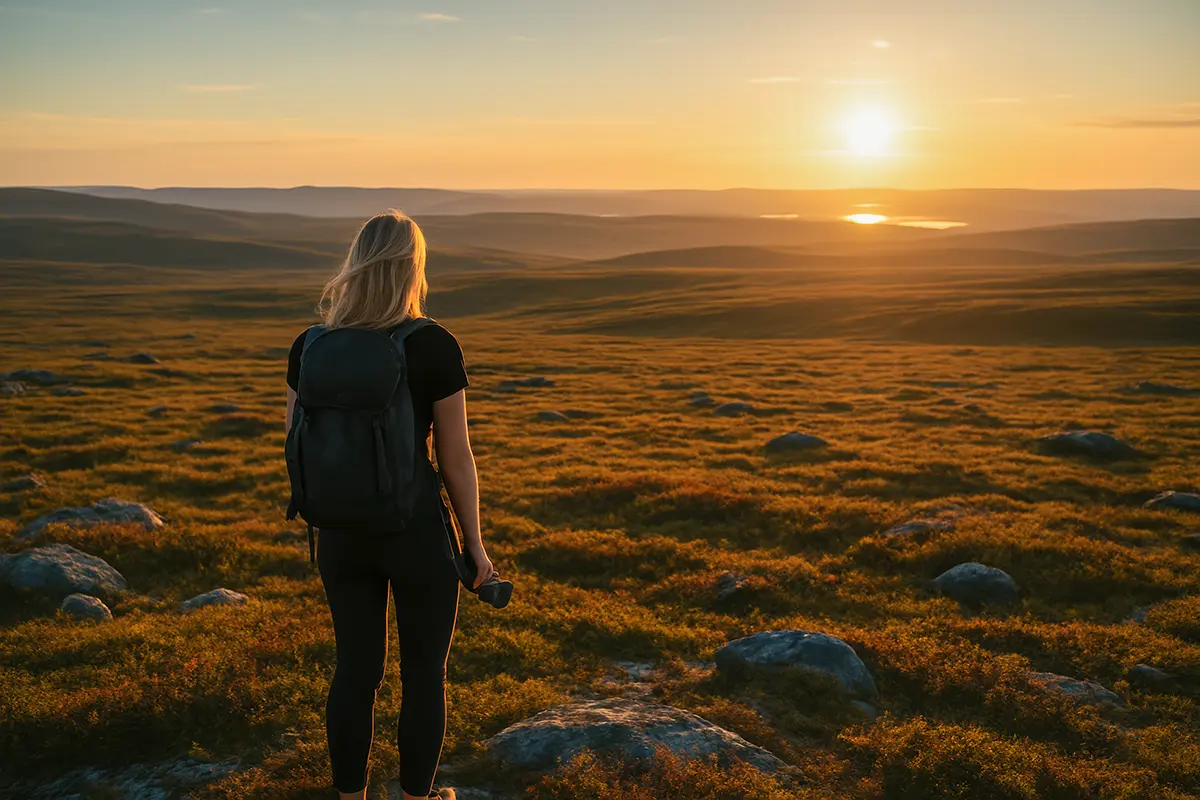
For those who want to experience the midnight sun in true wilderness.
What makes it unique: Endless tundra where you can see for 50 miles in every direction. During midnight sun, it feels like being on another planet.
Making the Most of Your Midnight Sun Experience
Embrace the Flexibility
Normal schedules become meaningless. Some of my best experiences happened when I abandoned plans:
- That random 1 AM hike that led to encountering reindeer
- The midnight fishing trip with locals in Reine
- The 3 AM coffee break that turned into a 4-hour photography session
Connect with Locals
Norwegians become incredibly social during midnight sun season. They’ll invite strangers to midnight barbecues, share secret hiking spots, and explain the cultural significance of this natural phenomenon.
Pro tip: Learn a few Norwegian phrases. “Midnattsol” (midnight sun) and “takk” (thanks) will open doors.
Document the Experience Beyond Photos
Keep a journal of how the light makes you feel at different hours. The midnight sun affects people psychologically in fascinating ways – some feel euphoric, others contemplative, many experience a strange timelessness that’s hard to describe.
Conclusion: Why Midnight Sun Changes You
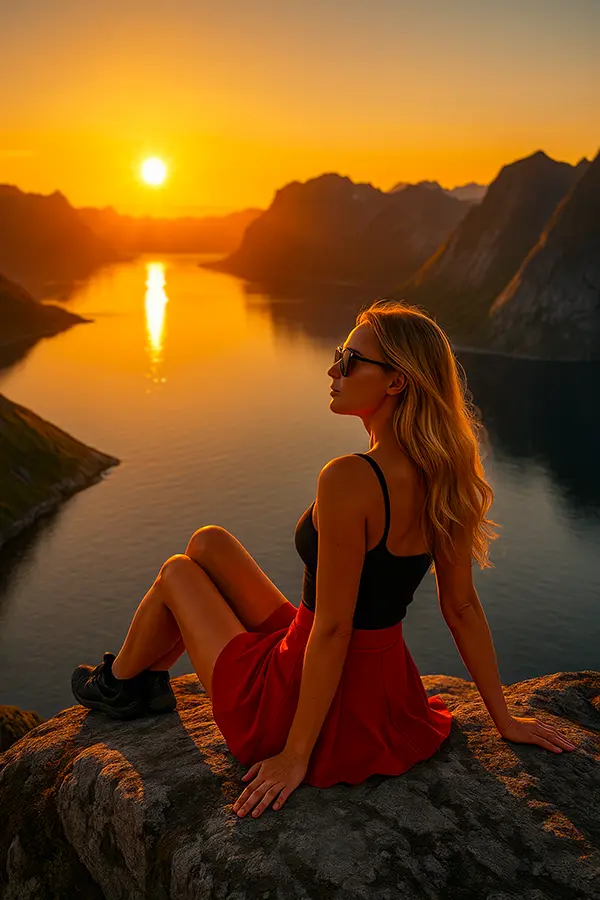
There’s something profoundly transformative about experiencing time differently. When the sun refuses to set, your internal clock gets confused, but your soul opens up to possibilities you never considered.
You’ll find yourself having deep conversations at 2 AM, hiking at hours that should be bedtime, and feeling more connected to natural cycles than ever before. It’s not just about seeing a cool phenomenon – it’s about experiencing life without the constraints of day and night.
The midnight sun teaches patience (the light changes slowly over hours), presence (you can’t rush this experience), and wonder (no matter how many times you see it, that floating sun still feels magical).
Norway’s midnight sun isn’t just a bucket list item – it’s a reset button for how you think about time, light, and being alive on this strange, tilted planet we call home.